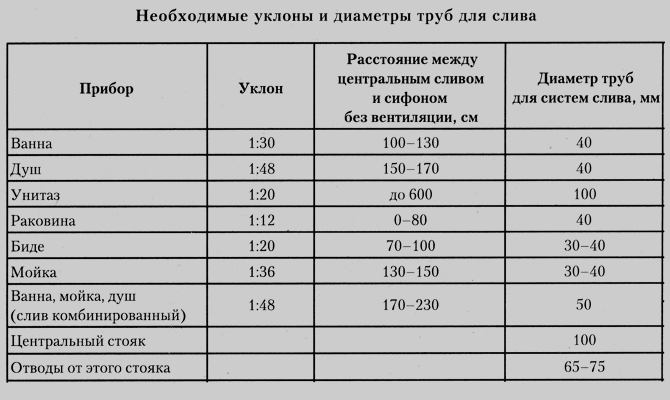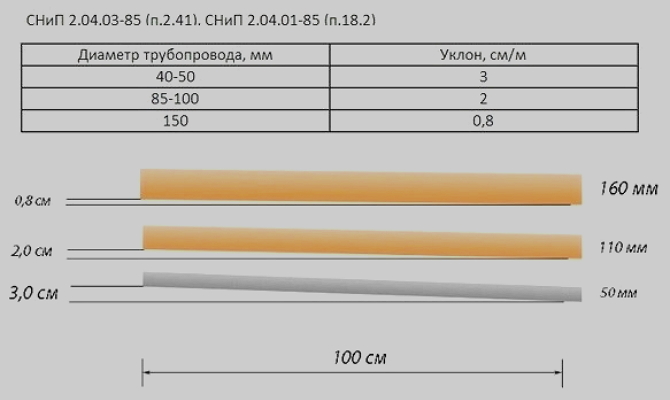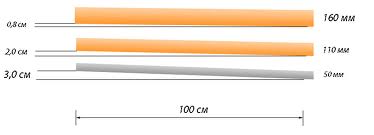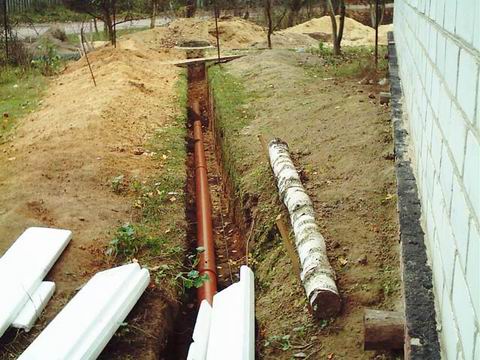What should be the slope of the sewer line. Optimal values for the outdoor system. Sanitary norms and rules
In order to understand what grade sewage pipe it must be necessary to calculate the key parameter of the flow velocity of the sewage stream. The minimum speed is 0.7 m / s. All details are specified in the normative document of SNiP.
There is a special formula with which you can calculate the parameters: V √ H / d ≥ K.
V - speed of movement of sewage;
H is the degree of filling;
d is the diameter;
K is the coefficient (in the case of glass and plastic pipes it is 0.5, for a pipeline made of another material, 0.6).
If approximately, for each running meter The pipeline should be two centimeters of deflection. That is for a branch pipe with a diameter of 40-50 mm, the slope of the sewer pipes per 1 running meter is 3 cm. The slope of the sewage pipe is 110 mm 2 cm per meter. We recommend that you take into account the diameter, length, number of joints, number of turns of the pipeline, and the number of connected plumbing fixtures.
It is also important to take into account the fillability of structures. It depends on the number of people living in the house. The more people live, the greater the filling capacity of the installation. The formula for the calculation of the fullness: y = H \\ D (H - height of the level, D - diameter of the branch pipe). The optimum value of fullness is 0.5-0.6. It depends on the material from which the nozzle is made. The nozzle made of glass and plastic has a filling of 0.5 due to a smooth surface, glass and ceramic fittings have a fill of 0.6 because of the rough surface.
During the design and subsequent installation of the pressureless waste water drainage system, it is necessary to set the correct slope of the sewage pipe. An error in greater or lesser side will result in improper operation of the incorrectly mounted section of the sewage system and may even cause its clogging.
1
The vast majority of sewage systems, especially domestic - non-pressure. That is, the sewage in them flows spontaneously (gravity) under the influence of gravity (gravity) of the Earth. Of course, such a movement is possible only if there is water to "fall".
That is, the level of the receiving end of the sewer pipe should be higher than the location of the outlet through which dirty water Removed further on the system. This is achieved by mounting the pipeline at a certain angle of inclination. As a result, the necessary height difference between the inlet and outlet openings of the sewer pipe is obtained.
It would seem that we can conclude that the greater the slope of the sewer pipe, the better. But not everything is so simple. Sewage drains abound in various inclusions. In them there is fat, the remains of food, small household rubbish and other dirt. All this is removed by water, but it can completely remove and wash the mud inclusions from the pipe only if it flows at a certain rate. Faster than necessary, you do not need!
Slope of sewer pipe
The optimum rate of sewage in a non-pressure sewage system is 0.7-1 m / s. So the system will be long and work perfectly without clogging, because water can effectively wash all sewage from the pipeline. Clog can occur unless in an extraordinary case. This speed can only be ensured by installing the pipe at a strictly defined angle of inclination.
If the slope is insufficient, because of the low water velocity, its head will be too small to entice and wash all mud inclusions, especially hard ones. They will settle on the walls of the pipe and in the end they will clog the system. Maybe even very quickly. And then it will be required.
If the slope is greater than necessary, then because of the higher flow rate, problems will arise. Water will not have time to wash off impurities - it will run away before solid inclusions are also removed from the pipe - and the same will happen as with insufficient inclination. There may be a head (pressure) of drains, on which the water closures of the sewage system are not designed. Then they will be broken and a specific smell of sewage will appear in the room with the pipeline.
2
Everyone knows that angles are usually measured in degrees (well, even in the derivatives of radians, hailstones and other units). When constructing pipelines, measures of length are used: in SNiPs, technical documentation and instructions - millimeters (mm), and many for convenience - centimeters (cm).
The angle of inclination of the pipe is measured in the difference in the height of the location of the ends of its meter section. That is, in mm or cm per 1 m of the pipe.

Tilting angle of sewage pipes
Knowing the desired slope angle and the length of the sewerage in meters, multiply their values. As a result, we obtain the value by which the inlet of the pipeline should be higher than the output one.
It should be noted that in the manuals, technical documentation and manuals, the level of the slope of the pipeline is often indicated in the form of a decimal fraction. It expresses the ratio of the reduction in the level of the sewage system in meters to the length of the pipe (1 m). That is, for example, if an inclination angle of 0.02 is encountered, this would mean that for every 1 m of the pipeline, a decrease in height should be 2 cm. And if the total length of the sewerage tap is 3 m, then in order to find out what its slope will be , we must multiply 2 by 3. We get that its lower point should be set 6 cm below the top.
Sometimes the angle of inclination is indicated as a ratio of one to some number, for example, 1:20. In this case, you need to perform a division operation to get the decimal fraction. For the proposed example, a value of 0.05 is obtained.
3
AT normative documents, SNiPax indicate a separate optimal angle of inclination of each diameter. And this is understandable, because the value of the internal section depends on the level of filling the system, installed at an angle determined by the volume of water. The optimum filling for smooth (plastic) pipes is 0.5 (up to half the cross-section), and for those having a rough surface (cast iron) 0.6. With such indicators, the flow rate of sewage in the system will also be optimal.

Optimal angle for sewer pipes according to SNiP
So, according to SNiPa for the following sewer pipes, the slope will be optimal:
- diameter 40, 50 mm - 30 mm (3 cm or 0.03) for each 1 m of the pipe length.
- diameter of 65-100 mm - 20 mm (2 cm or 0.02).
- with a diameter of 150 mm - 8 mm (0.8 cm or 0.008). When it is impossible to withstand the regulated value, it is allowed to set the slope to 0.007.
- with a diameter of 200 mm - 7 mm (0.7 cm or 0.007). The minimum allowed slope is 0.005.
Thus, for in-house sewage systems, which are assembled from pipes with diameters of 40-100 mm, the optimal angles are within the range of 0.02-0.03. In addition, for the organization of tap-offs from plumbing fixtures, there are separate norms for each device. For example:
- the drain from the washbasin is proposed to be made of a pipe with a diameter of 40-50 mm at a minimum angle of 0.025, and preferably under the recommended 0.035;
- from the toilet bowl - from the pipe 100 mm under the minimum and recommended slopes of 0.012 and 0.02 respectively.
For outdoor networks installed, as a rule, from pipes of 150-200 mm, optimal and minimum angles of inclination within the range of 0.005-0.008. For external sewage pipelines, the maximum permissible slope is also regulated. Its value is 0.15. If for some reason the slope of the street pipeline is more than 15 cm to 1 m in length, the whole system, including the house, will not be able to work effectively.
When designing and installing sewage systems in a country house you need to calculate everything in such a way that the system not only functions correctly, but it is reliable and, if possible, does not deliver any trouble to the owner. To achieve the desired result, such a notion as the slope of sewerage is very important. This applies to both the internal sewerage system and the external pipeline that connects the house to a central or local sewage system.
The angle of inclination of pipes, with a diameter of 50 and 110 mm.
Sewage is based on a self-sufficient (non-pressure) principle, and water has the property of flowing not upwards, but down. Those. if the pipes are located horizontally or with insufficient slope, then the drains entering them too slowly move or stagnate completely.
In the the result can be:
- Unpleasant smell.
- Rapid siltation and blockage.
Many owners, realizing this, are trying to increase the slope, suggesting that the more, the better. But this is also an erroneous decision, since undesirable processes occur at too high a rate of drainage of water.
Household sewage is not uniform, water does not have time to completely wash away from the inner walls of the pipe solid particles, they stick to the wall and form solid deposits, as a result:
- Siltation and blockage.
- Unpleasant smells from the sewer.
- Increased noise during the movement of drains.
- Increased loads on the pipe walls, which accelerates wear.
As we see, in both cases similar results are obtained. In fact, the slope of the sewage pipe is a long-timed, known and definite value regulated by GOST.
This parameter is influenced by the following parameters:
- The diameter of the pipe. The angle of inclination, as a rule, is inversely related to the diameter of the pipe.
- Filling capacity of the pipe. This value depends on the material of the pipe manufacturing, and is determined by the speed of movement of the liquid through the pipe. Calculated by the formula: Y= H/ D,
where Y is the required quantity, H is the level of the liquid level in the pipe, and D is equal to the diameter of the pipe. For understanding, we determine that if the pipe is empty, then the fill level is 0, and if the pipe is full, then -1. Optimal averaged value: for smooth pipes of plastic - 0.5, and for pipes that do not have a smooth inner surface (rough) 0.6.
The value of the angle of inclination is measured in centimeters. For example, a value of 0.05 cm means that the pipe should be reduced by 5 cm per 1 m of length. Exact calculation is made by the formula:
K ≤ V√ Y,
where K is the desired coefficient, V is the fluid flow rate through the pipe, and Y is the fill level.
The speed of flow in a gravity free flow is considered optimal at a value of 0.7-1 m / sec. Probably, such calculations look rather difficult, but this theory, in practice everything is simpler. There are already calculated and recommended parameters.
Internal sewerage system

The angle of slope of the pipes is 160, 200 mm.
Sewer system inside the house is characterized by a large number of pipes, draining drains from various plumbing devices, and docking nodes.
As a rule, in internal sewerage Practice is the use of pipes with a diameter not exceeding 50 mm (for drains from the bathroom, shower, sink, etc.) and from 100 to 160 mm (for attaching the toilet).
All this is connected to the riser by means of tees or crosses. The riser is located vertically, collects drains from all levels and has a diameter of 100 to 160 mm.
Calculate the slope angle according to the formula is not necessary, because there is no constant flow. Accepted slope of sewage pipefor internal sewerage system:
If the pipeline is long and various pipes are connected to it, it is difficult to calculate the slope for each individual section. You should follow the rule and choose an index from 0.015 to 0.03. To calculate the overall slope, you need to multiply the length of the tube oriented in the horizontal plane by the required angle of inclination. Those. if the pipe has a length of 5 m and the slope is 0.03 cm, then the discharge point should be 15 cm below the entry point.
Outdoor sewerage
Outer sewage pipeline Delivers drains from home to and passes under the ground. For it, pipes with a diameter exceeding 100 mm are used.
To determine the slope, you can use the table:
As a rule, the average value of the slope angle for an external sewage system is assumed to be 0.02 cm, i.e. The pipeline should be lowered by 2 cm each meter.
Also, if possible, the pipeline should not contain any turns at an angle of 90º; this can lead to clogging. Pipeline configurations without turns are not always easy to achieve, in this case, a manhole should be installed at the turn of the pipes, which will provide access to the pipes for monitoring and in the event of an accident. Inspection wells are also recommended to arrange every 20-25 m of the pipeline.
When connecting risers of internal sewer to an external sewer pipe, it is not allowed to directly connect vertical risers to a horizontal pipe, transitions are required (two at an angle of 45º or three at an angle of 30º).
How to lay pipes by level
To work you need a building level - laser or bubble. The laser level differs from the bubble level with increased accuracy and higher cost, therefore the bubble level is most widespread. The main thing is to make sure that it is not defective.
If we are talking about internal sewerage, then, as we know, the angle of inclination should be about 0.03 cm.
Sequencing:
- Take the meter level and to one end, using an adhesive tape, attach a bar of 3 cm.
- We collect the pipe, not using gaskets, starting from the point of entry to the sewer (the bottom point).
- In accordance with the level, raise the pipe (its upper point) to the desired height and designate the location of the fastenings.
- We fix the fastening, we assemble the pipe already with seals and fix it.
If we are talking about external sewage, then the same principle is used, but it will be more convenient to use a level of longer length. It is also necessary to take into account all the rules of installation of the external sewage system (turns, inspection, etc.).
When building a new building, be it a private house, bathhouse or even a workshop, almost always there is a question of the device of the water drain.
As a rule, gravity sewage systems are used to drain wastewater.
First you need to determine what should be the minimum slope of the sewer, since this directly depends on the depth of laying sewer pipes in the house or the ground, and accordingly, the location of the elements of sanitary ware: washbasins, toilets, baths,
Sewerage slope - norms and rules of calculation
There is a standard that uniquely determines the slope of the sewer pipe. This is SNiP 2.04.01-85, where everything is written down literally about the arrangement of sewerage inside the building, or what else it is called in a different way to the "fan system".
The rules of SNiPa define all the necessary conditions for the calculation of external sewage systems. It should be noted that the correct calculation and execution of the sewerage system, in the future, will save you unnecessary additional trouble.
Maximum / minimum slope of the sewer pipe - calculation
There are two parameters for the slope of the sewer pipe: the minimum and maximum. "Rules ..." prescribe different slopes for pipes inside buildings and pipes of the external sewage system.
So, inside the buildings, pipes with a diameter of no more than 100 mm are almost always laid. For them the following standards apply:
- The minimum slope of sewer pipes up to 50 mm in diameter should be 3 cm / m, and with a pipe diameter of 100 mm the slope will be 2 cm / m.
- Laying of external sewerage systems, as a rule, is performed by pipes with a diameter of 150 and 200 mm. For them slopes are defined: 150 mm - 8 mm / m, 200 mm - 7 mm / m.
- In any case, the maximum slope of the gravity drainage system should not exceed 15 cm per running meter of the system. It would seem that the more slope, the more accurate the water will leave the pipe without delay. But, in addition to water in the fan system, there are always solid particles, which must be washed away. And they move more slowly than the water itself.

Practice has shown that for the best drain the speed of water movement should be at least 0.7 m / s, and the water level should be at least 30% of the pipe diameter. Based on these considerations, all necessary calculations are constructed. There is a formula for calculating the slope of sewage pipes:
where the first factor indicates the water velocity in the system, the second, which is under the square root sign, represents the system filling factor, not less than 0.3. The result should be greater than or equal to 0.5 for pipes made of glass or plastic, or 0.6 for pipes of other materials.
In the absolutely overwhelming number of cases, the above values are suitable for use in practice.
- The maximum slope of the sewage system can be exceeded if the distance from the device to the system is not more than 1.5 m. For example, the outlet from the toilet.
- If the height difference is such that it requires a higher slope, you should put a vertical piece of pipe, and then continue to wiring the system with permissible gradients. Otherwise, the system will burst in time.
- For the sewage system, pipes with a diameter of:
- 40-50 mm for the sink
- 85-100 mm - for the toilet
- 100 mm - common outlet pipe
- In the most unsafe places should be installed plugs for cleaning.
If the sewer system is designed and laid correctly, it will serve you faithfully for long years.
The whole system of wastewater disposal, mainly in private buildings, is based on the principle of water flow in a natural way, that is, by gravity. For normal operation of this system there must be a certain slope of the sewage system. This means that the pipes should not be placed horizontally, but a slight slope is necessary to ensure that the water flows under the force of gravity and does not stagnate in the pipes.
If the slope of the pipeline is too small, the sewage will not flow completely, as a result, jams and plugs are possible. If the slope of the pipes is too great, solid wastewater fractions can settle on their walls, which also leads to the formation of plugs and the wear of the pipes.
Therefore, there is a concept - the minimum slope of sewerage, under which the normal flow of water is guaranteed. There are special formulas for calculating this value, however, it is known from practice, that the slope should be about two centimeters per one meter of pipe. This means that every meter of the following pipe should be lower by two centimeters. Calculate and make the required level of slope of pipes is not difficult. Consider a small example: the length of the drain pipe is 10 meters, which means that the horizontal distance between the beginning and the end of the pipe will be twenty centimeters.
But this is taken into account only with respect to pure water. And in the drains there are many solid fecal fractions and fat, which at a certain temperature freeze and can accumulate on the walls of the pipes. This can lead to the fact that the sewage system will often clog, and you will need to periodically clean it.
|
|
Therefore SNiPom (construction norms and rules) determines the order of construction of sewer systems. SNiP slope of the sewage pipe is taken into account already at the stage of the project of a private house or any other structure.
In accordance with these rules, pipelines with a diameter of up to 50 millimeters should have a slope of three centimeters per one meter of pipe, and for cross-sections of pipes up to 100 millimeters this figure is already two centimeters.
The slope of the sewage pipe SNiP is taken into account only in centimeters, and this value is never measured in degrees. Experts do not determine the slope of drain pipes in degrees, because even with a minimum error, the pipeline can not be laid correctly. And this will lead to an unbalanced operation of the sewage system, there will be congestion, traffic jams and pipe cleaning.

Slope of the pipelines of the internal sewage system
Some tips of specialists when installing internal sewerage:
- turning the pipes at right angles when they are horizontal is not allowed, use bends with an angle of 45 degrees;
- at vertical arrangement pipes, right angles are permissible;
- in places where the pipes rotate, audit connections should be made to monitor and repair the system;
- at a small distance with a small pipe length, the slope can be made large (more than the permissible norm).
It should be noted that SNiP slope sewage within the plot to change the types of wiring prohibits. Otherwise, the hydrodynamic characteristics of the pipeline will be violated, which can lead to water hammering and, as a result, pipe failure. If there is any obstacle during the laying of pipes, it is better to bypass it.
Calculation of the slope of the sewage system during installation of the external system
External sewerage is designed to deliver sewage from the house to the septic tank. Pipes for this can use a variety of:
- cast iron,
- asbestos-cement,
- corrugated polyethylene elements.

The depth of the trench, depending on the climatic conditions of the region, can range from 70 centimeters to two meters.
The bottom of the trench should be deeper than the planned level by about 20 centimeters.
This value depends on the diameter of the pipe, and it may also be necessary to fill the substrate to equalize the level of passage of the pipes.
In order to make the correct deviation of the sewage system, it is necessary to drive two pegs at the beginning and end of the trench and pull the rope. In this case, the bottom of the trench can be made even, without holes and deflections, and set the optimal angle of slope of the pipes. Then, at the bottom of the ditch, it is necessary to make a sand pillow about five centimeters thick, in order for the pipeline to lie flat, and there were no hard protrusions that could damage the pipeline.
When building a system for draining waste water and waste, a big role is played by the slope of the pipes. It is important to comply with the norms of the sewage slope for normal and trouble-free operation of the entire system. Depending on the length of the pipeline, the diameter and material of the pipes, the slope should be from 1.5 to 3 centimeters per one running meter of the pipe. These values are checked by time and practice of specialists.












